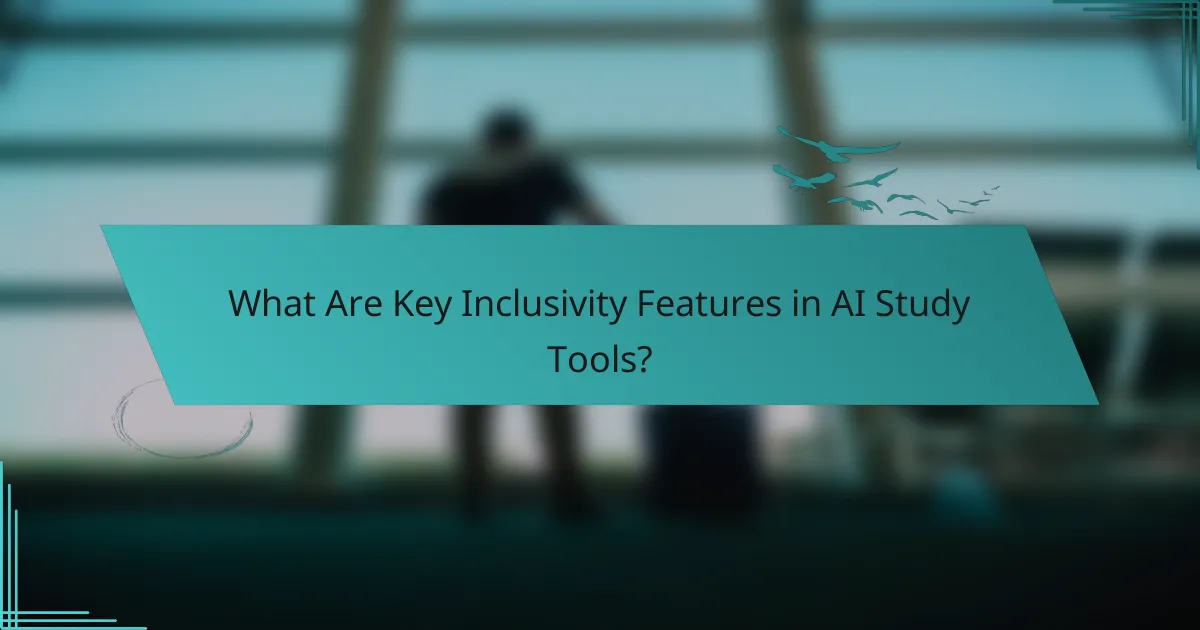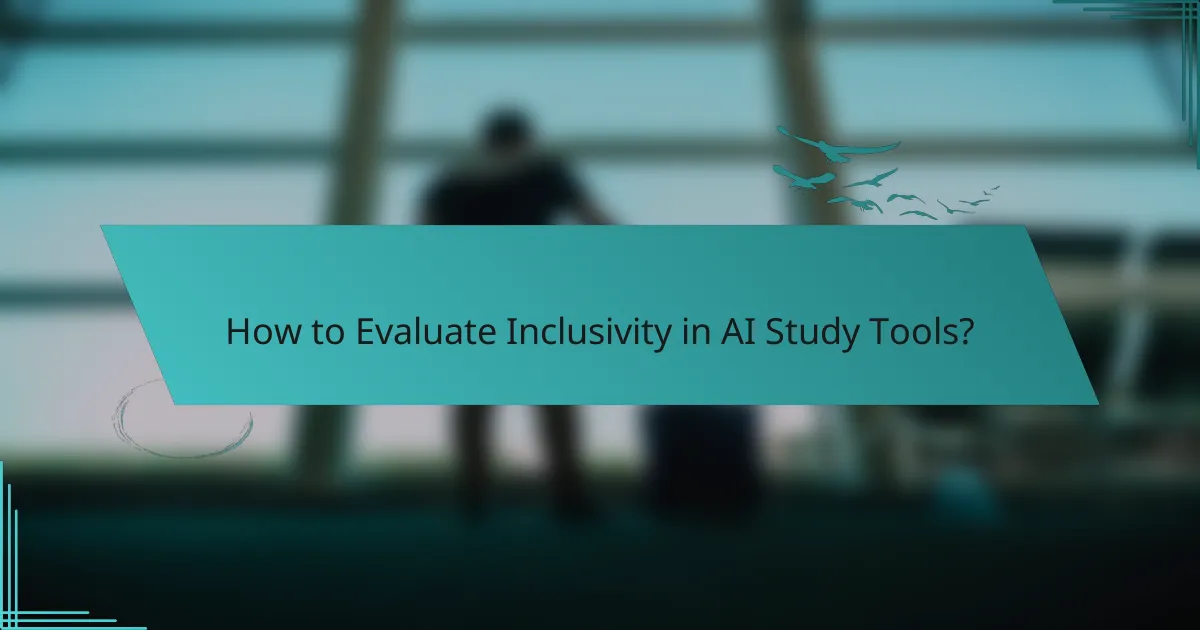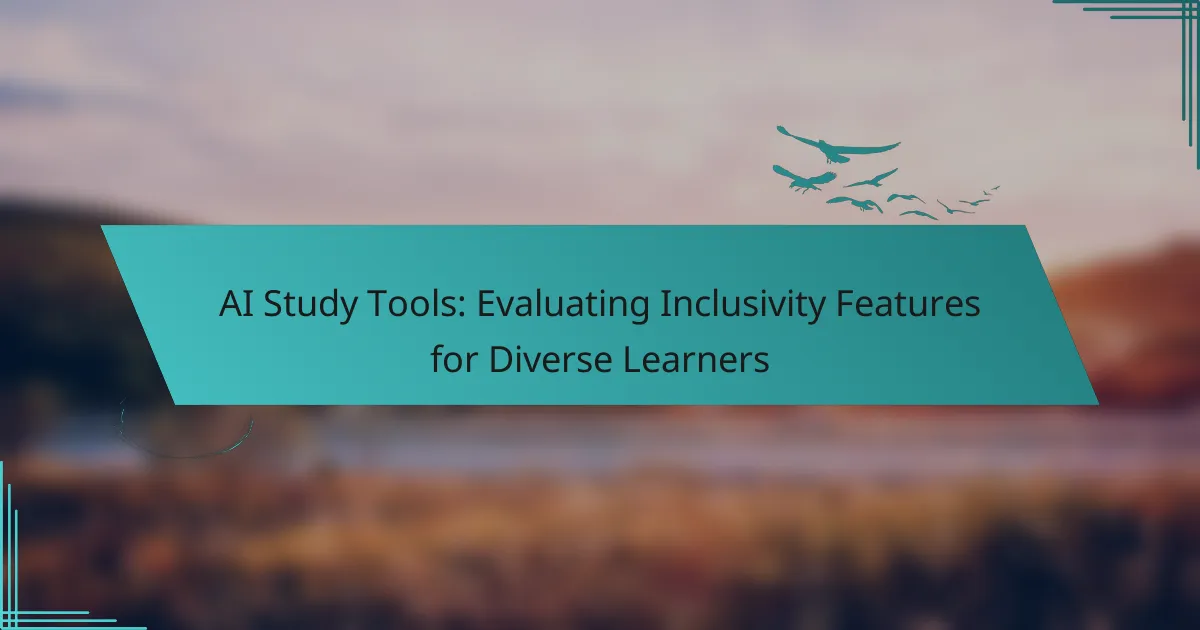AI study tools are transforming the educational landscape by providing personalized resources that address the unique needs of diverse learners. By incorporating key inclusivity features, these tools create accessible environments that empower all students to engage effectively with educational content, regardless of their abilities or learning preferences.

How Do AI Study Tools Support Diverse Learners?
AI study tools enhance learning experiences for diverse learners by offering tailored resources that cater to individual needs. These tools utilize technology to create inclusive environments, ensuring that all students can access and benefit from educational materials.
Personalized Learning Paths
Personalized learning paths allow students to progress at their own pace, adapting content based on their unique strengths and weaknesses. AI algorithms analyze user performance and preferences to recommend specific resources, ensuring that learners receive targeted support. For instance, a student struggling with math concepts may be directed to practice exercises that reinforce foundational skills before advancing.
To implement personalized learning effectively, educators should regularly review student progress and adjust learning paths as needed. This approach fosters engagement and motivation, as learners see their growth and receive encouragement tailored to their individual journeys.
Accessibility Features
Accessibility features in AI study tools are designed to accommodate learners with disabilities, ensuring equitable access to educational content. Common features include screen readers, text-to-speech options, and alternative text for images, which help visually impaired students engage with materials. Additionally, adjustable font sizes and color contrast settings can assist those with dyslexia or other reading challenges.
When selecting AI tools, educators should prioritize those that comply with accessibility standards, such as the Web Content Accessibility Guidelines (WCAG). Regular feedback from users with disabilities can also help refine these features, making learning more inclusive.
Language Support
Language support features in AI study tools cater to multilingual learners by providing content in various languages and facilitating translation. This can include bilingual glossaries, subtitles for instructional videos, and the ability to switch between languages seamlessly. Such support is crucial for students who may not be proficient in the primary language of instruction.
To enhance language learning, tools can incorporate contextual vocabulary exercises and cultural references relevant to the learner’s background. This not only aids comprehension but also fosters a sense of belonging within the educational environment.
Adaptive Feedback Mechanisms
Adaptive feedback mechanisms provide real-time responses to student inputs, allowing for immediate correction and guidance. These systems analyze learner interactions and adjust feedback based on performance, helping students understand their mistakes and learn from them. For example, if a student consistently answers questions incorrectly, the tool might offer hints or additional resources to clarify concepts.
Effective adaptive feedback should be constructive and specific, guiding learners toward improvement without discouragement. Educators should encourage students to engage with feedback actively, using it as a tool for growth rather than merely a score.

What Are Key Inclusivity Features in AI Study Tools?
Key inclusivity features in AI study tools enhance accessibility for diverse learners by accommodating various learning styles and needs. These features ensure that all users, regardless of their abilities or preferences, can effectively engage with educational content.
Text-to-Speech Capabilities
Text-to-speech (TTS) capabilities convert written text into spoken words, making content accessible for users with visual impairments or reading difficulties. This feature allows learners to listen to study materials, which can improve comprehension and retention.
When evaluating TTS options, consider the quality of the voice, language support, and the ability to adjust speed and pitch. Tools that offer multiple voice choices can cater to user preferences, enhancing the overall experience.
Visual Learning Aids
Visual learning aids, such as diagrams, charts, and infographics, help learners who benefit from visual stimuli. These aids can simplify complex concepts and make information more digestible, particularly for those with learning disabilities like dyslexia.
Look for AI tools that integrate visual elements seamlessly with text. Features like customizable color schemes and the ability to enlarge images can further support users with specific visual needs.
Customizable User Interfaces
Customizable user interfaces allow learners to tailor their study environment according to their preferences and requirements. This can include adjusting font sizes, colors, and layout, which is particularly beneficial for users with visual impairments or cognitive challenges.
When selecting an AI study tool, prioritize those that offer flexible settings. A user-friendly interface that can be adapted to individual needs can significantly enhance the learning experience and promote engagement.

Which AI Study Tools Are Best for Inclusivity?
AI study tools that prioritize inclusivity cater to diverse learning needs by offering features like accessibility options, customizable interfaces, and support for various learning styles. Tools that excel in these areas can significantly enhance the learning experience for all students, especially those with disabilities or unique educational requirements.
Microsoft OneNote
Microsoft OneNote is a versatile note-taking application that supports inclusivity through features like audio notes, text-to-speech, and the ability to organize content in a flexible manner. Users can customize their workspace with different colors and fonts, making it easier for individuals with visual impairments to navigate.
OneNote’s integration with other Microsoft tools, such as Immersive Reader, enhances accessibility by providing reading support and translation options. This makes it a strong choice for educators looking to accommodate a wide range of learning preferences.
Google Classroom
Google Classroom facilitates inclusivity by allowing teachers to create a structured environment that supports diverse learners. Its integration with Google Docs and other applications enables students to collaborate easily, while features like assignment differentiation help tailor tasks to individual needs.
Accessibility features, such as screen reader compatibility and voice typing, ensure that students with disabilities can engage fully with the material. Additionally, Google Classroom’s user-friendly interface promotes ease of use for both students and educators.
Quizlet
Quizlet enhances inclusivity by offering a variety of study modes, including flashcards, games, and practice tests, catering to different learning styles. The platform allows users to create custom study sets, which can be tailored to specific educational needs, making it suitable for diverse learners.
Quizlet also provides accessibility features like audio pronunciations and visual aids, which can benefit students with learning disabilities or those who require additional support. By leveraging these tools, educators can create a more inclusive learning environment that encourages all students to succeed.

How to Evaluate Inclusivity in AI Study Tools?
Evaluating inclusivity in AI study tools involves assessing how well these tools cater to diverse learners’ needs. Key considerations include accessibility features, language support, and adaptability to various learning styles.
Criteria for Assessment
When assessing inclusivity, focus on several key criteria. Look for features that enhance accessibility, such as text-to-speech options, adjustable font sizes, and color contrast settings. Additionally, consider the availability of multilingual support and culturally relevant content.
Another important aspect is the adaptability of the tool to different learning styles. Tools that offer personalized learning paths or varied content formats, such as videos, quizzes, and interactive exercises, can significantly enhance the learning experience for a wider audience.
User Feedback and Reviews
User feedback is crucial in evaluating the inclusivity of AI study tools. Check reviews on educational platforms and forums to gather insights from actual users, especially those from diverse backgrounds. Look for comments on how well the tool meets specific needs, such as support for learners with disabilities or non-native speakers.
Additionally, consider conducting surveys or focus groups with a diverse set of users to gather direct feedback. This qualitative data can reveal strengths and weaknesses that may not be apparent from formal assessments alone, helping to identify areas for improvement.

What Are the Challenges in Implementing Inclusivity Features?
Implementing inclusivity features in AI study tools presents several challenges, including financial constraints and a general lack of awareness among developers and educators. These obstacles can hinder the effective integration of tools that cater to diverse learners’ needs.
Cost of Development
The cost of developing inclusivity features can be significant, often requiring substantial investment in research, design, and testing. Budget constraints may limit the ability of organizations to prioritize these features, especially for smaller companies or educational institutions.
For instance, creating adaptive learning technologies that respond to individual learning styles may involve hiring specialized personnel or investing in advanced software. Organizations should consider allocating a portion of their budget specifically for inclusivity initiatives to ensure these features are not overlooked.
Lack of Awareness
A widespread lack of awareness about the importance of inclusivity features can impede their adoption. Many developers may not fully understand the diverse needs of learners, leading to a one-size-fits-all approach that fails to accommodate various learning styles.
To address this, organizations should invest in training and resources that highlight the benefits of inclusivity in educational tools. Engaging with diverse learner communities can provide valuable insights and foster a culture that prioritizes inclusivity in product development.

What Are Future Trends in AI Study Tools for Inclusivity?
Future trends in AI study tools for inclusivity focus on enhancing accessibility and engagement for diverse learners. These advancements aim to create personalized learning experiences that accommodate various learning styles, needs, and backgrounds.
Increased Use of AI Analytics
AI analytics are becoming essential in understanding learner behavior and performance. By analyzing data, these tools can identify gaps in knowledge and tailor study materials to meet individual needs, improving overall learning outcomes.
For instance, platforms that track user interactions can provide insights into which topics students struggle with most. This allows educators to adjust their teaching strategies or recommend specific resources to help students succeed.
Integration of VR and AR Technologies
Virtual Reality (VR) and Augmented Reality (AR) technologies are increasingly being integrated into AI study tools to create immersive learning experiences. These technologies can simulate real-world scenarios, making learning more engaging and relevant for diverse learners.
For example, a VR application might allow students to explore historical events or scientific concepts in a 3D environment, catering to visual and kinesthetic learners. This hands-on approach can enhance understanding and retention of complex subjects.
Focus on Emotional Intelligence in Learning
Emotional intelligence is gaining recognition as a critical component of effective learning. AI study tools are beginning to incorporate features that assess and respond to learners’ emotional states, fostering a supportive educational environment.
Tools that adapt content based on a learner’s emotional feedback can help maintain motivation and engagement. For instance, if a student shows signs of frustration, the system might offer encouragement or switch to a simpler explanation, promoting a more positive learning experience.
